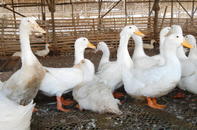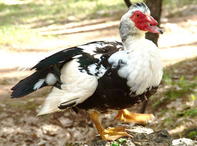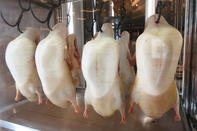Duck farming for meat is a niche market in South Africa, with a few small free-range farms supplying restaurants, retailers, farmers’ markets, and directly to the public.

However, most duck meat consumed in South Africa is imported from Thailand, Hungary, China and Brazil. These imports, even though cheaper than South African duck meat, are not considered the same quality as free-range ducks grown and supplied by South African duck farmers.
Ducks are also farmed for eggs, down and feathers as well as the production of foie gras, which the fattened livers of force-fed ducks and geese. The production of foie gras is illegal in South Africa, but it is legal to import it.
Global Duck Meat Producers
The majority of duck meat (over 80%) is produced in Asia, with China as the biggest producer of duck meat in the world. China is, however, only the third-biggest importer of duck meat. This implies that China is a consumer of its own duck meat production.
The world’s top-3 importers of duck meat are Saudi-Arabia, Germany, and France. Africa produces around 2% of the world’s duck meat, with notable producers being Egypt and Madagascar.
Duck Breeds in South Africa

Most important duck breeds for meat production are Pekin, Muscovy, Aylesbury and Rouen.
The Pekin duck, which originated in China, is a white duck with a bright orange bill and an upright demeanour. It matures slightly slower than the Aylesbury but is the predominant breed used for commercial meat production worldwide, including South Africa. Pekin ducks are hardier and more economical to raise that the Aylesbury. The Pekin lays up to 160 eggs per year and can be used as a multi-purpose breed - for both egg and meat production (‘Peking’ is the name of a popular dish).
The large Aylesbury duck from England has a long, broad and deep body with a light-pink bill and white feathers. Originally called ‘White English’ the Aylesbury is bred for its white meat and white down. The meat of the Aylesbury duck is uncoloured due to its all white-feathered body. The Aylesbury is a popular meat bird that can lay up to 110 eggs per year.
The Muscovy (also called Barbary duck) is a duck that originated from South America and exhibits a very efficient feed-to-meat conversion. The Muscovy has white and black/grey feathers with a bright red crest around their eyes and bill. These ducks are good foragers, not very noisy, not prone to disease and the breed adapts well to cold conditions. The Muscovy lays up to 100 eggs per year.
The beautiful Rouen duck is from France and resembles the Mallard or wild duck with its dappled appearance, grey body and green-coloured back and neck. The Rouen ducks’ bills are wide and orange with black spots. These large ducks have a square body and are excellent foragers, yet slow growers. They can lay up to 100 eggs per year.
Mule ducks are also used for meat and fat liver (foie gras) production. The Mule is a cross with a Moscovy duck and other duck species to produce a sterile duck. The Mule duck produces lean meat and is preferable in more health-conscious circles.
Indian Runners and Khaki Campbells are prolific egg layers and are often used for duck egg production.
What is Peking Duck?

‘Peking duck’ is the name of the breed of duck used for meat production, while ‘Peking duck’ is the name of a culinary dish.
Peking duck is made by pumping air between the skin and the meat before cooking. The duck is then roasted and the crisped skin and meat are served separately. The duck meat is served with hoisin sauce and rolled with spring onion in thin pancakes.
By Marinda Louw